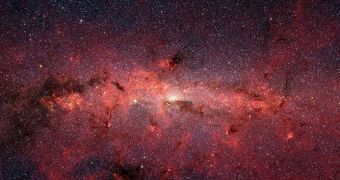A team of scientists from the National Radio Astronomy Observatory (NRAO) believe it may have found a new explanation for the peculiar, cloud-like structures that hover above the plane of our galaxy. Astronomers and astrophysicists have been trying to make sense of these formations for many years, and the team now proposes that they are basically nothing but fractured remnants, which may have originated in superbubbles produced by supernovae and stellar winds. The work could have significant implications for the way chemicals are moved throughout the galaxy, potentially setting the stage for the emergence of early life here on Earth, Wired explains.
“There’s a fundamental, interesting connection between gas far away from the Milky Way and the amount of star formation below it in the galactic plane,” NRAO expert F. Jay Lockman said in an interview. Speaking yesterday to experts gathered in Miami, Florida, at the 216th annual meeting of the American Astronomical Society (AAS 2010), he added that everything inside the Milky Way, ranging from gas and dust to solar systems, spiral arms and black holes, lie within the same plane. The clouds do not reside in the same plane, he added. The situation is similar to that of some objects in the Kuiper Belt, beyond the orbit of Pluto. These space rocks do not spin around the Sun in the same plane as the rest of the planets.
The Milky Way, like most other massive galaxies, features a massive halo around its central core, both above and below the plane. But the NRAO team discovered huge clouds located between the plane and the halo, using the West Virginia-based Green Bank Telescope. These formations are thousands of times more massive than the Sun, and their origins were not immediately visible. “This turned my whole conception of what was going on upside down. It’s very much like seeing, all your life, a distant hillside that’s covered in green fuzz. Then one day you get a pair of binoculars and you look and say, ‘My God, there’s trees’!” the scientist explained.
The team revealed that Earth, and other planets like it, did not have the necessary conditions to form when the galaxy first developed. “Put the Earth in a blender and you’ve got silicon, magnesium, the stuff that’s formed in supernovas,” explains Boston University professor Tom Bania. Lockman said that, if indeed the clouds came from supernova remnants and other superbubbles, then “it’s quite possible that these clouds as they fall back to the Milky Way are the way that metals get mixed in through the disk, and this controls the overall evolution of the interstellar medium and the next generation of stars.”

 14 DAY TRIAL //
14 DAY TRIAL //